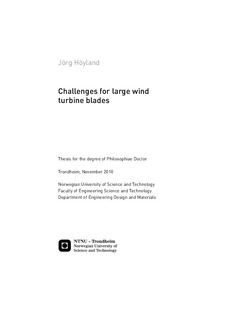| dc.contributor.author | Höyland, Jörg | nb_NO |
| dc.date.accessioned | 2014-12-19T12:27:09Z | |
| dc.date.available | 2014-12-19T12:27:09Z | |
| dc.date.created | 2011-09-12 | nb_NO |
| dc.date.issued | 2010 | nb_NO |
| dc.identifier | 440239 | nb_NO |
| dc.identifier.isbn | 978-82-471-2417-8 (printed ver.) | nb_NO |
| dc.identifier.uri | http://hdl.handle.net/11250/241446 | |
| dc.description.abstract | With global climate problems receiving increasingly international political attention,most European nations are looking for sources of renewable energy. Wind turbines area promising source of renewable energy and their numbers have steadily increasedsince the introduction of the modern wind turbine in the 1970s. The largest units todayhave a rated power of 7 MW and blades ranging up to 62.5 m in length. Offshore windturbines have access to stronger winds with less turbulence, thereby increasing theenergy output of each unit. Offshore turbines will also have a lesser environmentalimpact than onshore turbines. It is believed that the development of offshore wind turbineswill encourage the development of even longer blades.
The main spar geometry of a 100 m wind turbine blade was established in order to evaluatehow the use of carbon and glass fiber composites would affect the design. A hybridsolution using UD carbon fiber for global stiffness and ±45° glass fiber plies for bucklingresistance was also developed. The ultimate loads were calculated for blades with pitchcontrol and blades experiencing failure of pitch control during the 1-year and 50-yearextreme gust. The DNV-OS-J102 standard for wind turbines was used in the calculationof safety factors for both loads and material strength criteria. The distribution of ±45°anti-buckling plies by buckling analysis is extremely time consuming and therefore aprogram for automatic ply distribution was developed. The Matlab program interactedwith the FEM software Abaqus, defining input files and extracting results, and proved tobe highly efficient. The results from the FEM analyses were combined with a simple costmodel in order to evaluate both the weight and cost of the different spar solutions.
Important weight reductions can be obtained by optimizing the performance of the composite laminate in the spar. Several sub-models of the 100 m spar were created withthe aim of optimizing the spar’s buckling performance. The angle and distribution ofboth the ±45° and UD plies were systematically altered in order to increase the bucklingload. The introduction of ply homogenization and core material in the flange was alsoevaluated and yielded the largest increases of buckling load. The results from the optimizedsub-models were implemented in a 100 m spar and found to decrease theamount of ±45° plies by 50 %.
A 6 m scaled main spar of glass fiber composite was produced by resin infusion. Thespar was tested in a 4-point bending test and designed to fail by buckling of the topflange. In order to control the location of the buckling failure, an artificial imperfectionwas introduced in the middle of the top flange during manufacturing. The imperfectionis representative for imperfections found during manufacturing of wind turbine spars. Inaddition to measuring force and global deflection, 25 strain gages were installed tomonitor the spar.
Finally, a FEM analysis of the 6 m spar was developed and correlated with the experimentalresults. By implementing the imperfection in the compression spar and the useof non-linear analysis, the strain patterns from the test results were successfully reproduced | nb_NO |
| dc.language | eng | nb_NO |
| dc.publisher | Norges teknisk-naturvitenskapelige universitet, Fakultet for ingeniørvitenskap og teknologi, Institutt for produktutvikling og materialer | nb_NO |
| dc.relation.ispartofseries | Doktoravhandlinger ved NTNU, 1503-8181; 2010:216 | nb_NO |
| dc.title | Challenges for large wind turbine blades | nb_NO |
| dc.type | Doctoral thesis | nb_NO |
| dc.contributor.department | Norges teknisk-naturvitenskapelige universitet, Fakultet for ingeniørvitenskap og teknologi, Institutt for produktutvikling og materialer | nb_NO |
